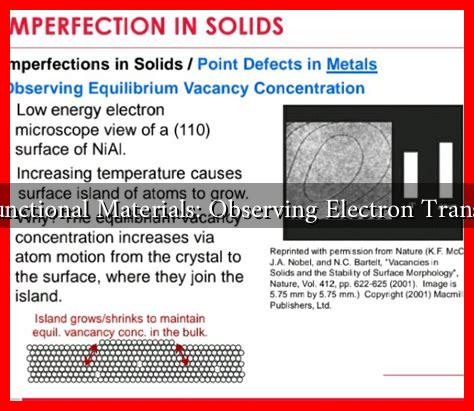-
Table of Contents
- Next-Gen Functional Materials: Observing Electron Transfer in Solids
- The Basics of Electron Transfer in Solids
- Types of Electron Transfer
- Techniques for Observing Electron Transfer
- Examples of Experimental Techniques
- Applications of Understanding Electron Transfer
- Case Study: Solar Cell Technology
- The Future of Functional Materials
- Key Takeaways
Next-Gen Functional Materials: Observing Electron Transfer in Solids
Functional materials play a crucial role in various industries, from electronics to energy storage. Understanding electron transfer in solids is essential for developing next-generation materials with enhanced properties. In this article, we will explore the importance of observing electron transfer in solids and its implications for the future of functional materials.
The Basics of Electron Transfer in Solids
Electron transfer in solids refers to the movement of electrons between atoms or molecules within a solid material. This process is fundamental to the behavior of materials and can significantly impact their properties. By studying electron transfer, researchers can gain insights into the conductivity, magnetism, and optical properties of solids.
Types of Electron Transfer
- Band-to-band transitions
- Charge transfer between ions
- Electron hopping between localized states
Techniques for Observing Electron Transfer
There are several experimental techniques used to observe electron transfer in solids, including spectroscopy, microscopy, and electrochemical methods.
. These techniques allow researchers to study the dynamics of electron transfer at the atomic and molecular levels.
Examples of Experimental Techniques
- X-ray photoelectron spectroscopy (XPS)
- Scanning tunneling microscopy (STM)
- Cyclic voltammetry
Applications of Understanding Electron Transfer
Understanding electron transfer in solids has numerous applications in various fields, including:
- Developing more efficient solar cells
- Designing high-performance batteries
- Creating novel electronic devices
Case Study: Solar Cell Technology
Researchers have used their knowledge of electron transfer in solids to improve the efficiency of solar cells. By optimizing the materials and interfaces involved in electron transfer processes, they have been able to increase the conversion efficiency of solar cells, making them more cost-effective and sustainable.
The Future of Functional Materials
Advances in our understanding of electron transfer in solids are paving the way for the development of next-generation functional materials with enhanced properties. By harnessing the principles of electron transfer, researchers can create materials that are more conductive, durable, and versatile.
Key Takeaways
- Electron transfer in solids is essential for the behavior of materials.
- Experimental techniques such as spectroscopy and microscopy are used to observe electron transfer.
- Understanding electron transfer has applications in solar cell technology, battery design, and electronic devices.
In conclusion, observing electron transfer in solids is a critical aspect of developing next-generation functional materials. By studying the dynamics of electron transfer, researchers can unlock new possibilities for creating materials with enhanced properties and applications.





